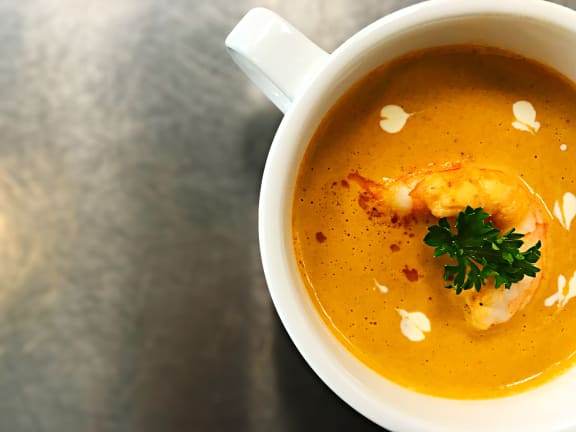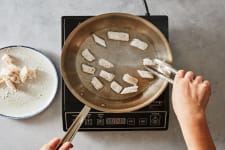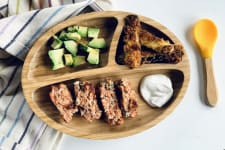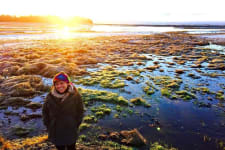Don’t call it chowder! Served hot or cold, a creamy, velvety seafood bisque is a crustacean-rich soup that you can enjoy any time of year, whether you want to cozy up by the stove or chill out on a warm day. Our recipe shows you how to make seafood bisque from briny Dungeness crab and sweet spot prawns from Alaska, with no added cream.
Many seafood bisque recipes integrate cream into the soup, while others blend in cooked rice to give the bisque a creamy weight. Our crab and shrimp bisque recipe uses the latter technique, which gives the bisque a lighter feel, makes it easier to adapt to a dairy-free diet — and in our opinion leaves it with a more pleasing texture if you decide to serve it chilled. And without cream, learning how to make seafood bisque is one hundred percent about learning how to make a delicious stock.
Bisque is a beginner-friendly recipe, though it does require you to spend some time in the kitchen moving things from vessel to vessel, especially when you’re using crustaceans that are still in the shell. Things could get a little messy. But using fresh ingredients is key to making a good stock, so forget about shortcuts and embrace the extra effort it takes to make this the right way.
You’ll need a leisurely 20 minutes (ideally with the help of a hungry assistant!) to work your way through the Dungeness crab and spot prawns, removing the meat from the shells. Reserve any juices that are released while breaking the crab down, as they contain lots of flavor! Also, save any liquid that drained from the crab while it was thawing either in the refrigerator or on the stove. If you don’t have spot prawns, you can just add more crab to the recipe instead.
Instead of discarding these shells, you’ll fry ‘em up in a bit of butter or olive oil in order to extract every drop of flavor from this wild-caught catch, creating the base of a rich, crustacean-forward stock to use in your bisque. Since you’re being so resourceful, we’ll ask you to consider adding in the peels and trimmed bits of carrot, leeks, celery, garlic, and herbs into this stock as well, rather than discarding these parts outright.
The substantial portions of the carrots, leeks, celery and garlic will form the veggie mixture that you’ll saute in olive oil before eventually blending into the bisque. A bay leaf gives the bisque some herbaceous depth, while a bit of tomato paste, a splash of brandy, and glug of white wine bring in some necessary acidity and fragrance to the pot.
Everything is blended together with a scoop of long-grain white rice into a smooth soup just before serving; using freshly cooked long-grain white rice is essential, as it is starchy enough to thicken the soup and fluffy enough to be pulverized in a blender. You can get your rice going while you’re shelling the crab and spot prawns so that it’s ready for you once you start cooking the bisque; we suggest make enough so that you’ll have plenty of day-old rice to use for a sublime king crab fried rice or salmon fried rice dinner tomorrow.
A dollop of creme fraiche added just before serving if you like, along with a pinch of tender green herbs (think chervil, tarragon, parsley or chives), are the perfect finishing touches for seafood bisque.






